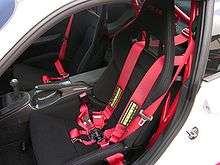Bucket seat

A bucket seat is a seat contoured to hold one person, distinct from bench seats which are flat platforms designed to seat multiple people. Bucket seats are standard in fast cars to keep riders in place when making sharp or quick turns. According to the Oxford English Dictionary, the name derives from the seat "partly resembling a bucket in shape".[1]
Racing vehicles usually have only one bucket seat. Vehicles sold to the general public often have two bucket seats in the front compartment, and may contain more in a rear compartment. Commercial aircraft now have bucket seats for all passengers.
Automobile bucket seats first came into use after World War II on European small cars, due to
- Their relatively small size compared with a bench seat
- Lack of seating room for a middle passenger, due to the presence of a floor-mounted shifter and parking brake lever
The first motor sports and fast road bucket seats in Europe were manufactured by Colin Folwell, who subsequently founded Corbeau Seats in the UK in 1963.[2]
The bucket seat trend was especially apparent in sporty cars, particularly two-seaters, most of which were manufactured in European nations.
Some bucket seats may also be swivel seats as well.
Use in American cars
For decades, American cars were typically equipped with bench seats, which permitted three-passenger seating. The advent of compact cars and specialty vehicles such as the Ford Thunderbird in the late 1950s and early 1960s, and sporty versions of both standard-sized and compact cars, accelerated the bucket-seat trend in domestic cars around 1960.
By 1962, more than 1 million U.S. built cars were factory equipped with bucket seats; often, these were fitted with a center console containing a gear shifter and possibly other features between the seats. The popularity of the bucket seat grew with the advent of sporty compact cars (or "pony cars") such as the Ford Mustang. With the introduction of subcompact-sized automobiles such as the Chevrolet Vega and Ford Pinto, bucket seats were used due to the lack of seating room and the use of floor-mounted levers for the gear shifter and parking brake.
While bucket seats continued to gain popularity among compact and sports cars, the traditional bench seat, which could seat up to three people abreast, continued to be the preferred front seating arrangement in larger cars and trucks until the late 1990s. By the 1990s, a few mid- and full-sized domestic cars, as well as trucks, offered bucket seat-console front seating options, for customers who wanted a sports-car image or personalized feel to their car.
Recently, as U.S. cars were designed smaller in order to meet increasingly stringent fuel economy and safety standards as well as intense competition from imported cars (particularly Japanese models), bucket seats became the de facto front configuration among domestic cars. The last sedan to come with a front bench as standard was the 2011 Lincoln Town Car and the last sedan to even offer it as an option was the 2013 Chevrolet Impala. As of 2015, only some pickup trucks retain the front bench seat.
As with carpooling, fuel economy averages per carpool passenger has increased as per the stringent fuel economy standards that subtraction of one front middle passenger is a rather moot subtraction from the fuel economy equation.
Rear seating
Although rear seating in automobiles largely uses bench seats, some 2+2 cars have bucket seats in the rear. Long-wheelbase variants of full-size luxury cars, such as the Lexus LS 460L have an "executive seating package" option that reduces the rear to two passengers but provides them with more amenities.[3] The Porsche Panamera, despite its large size, only offers bucket seats as the rear configuration.[4]
Third row seating
Bucket seats are also used in passenger vans and minivans, although they are not generally referred to as such; for instance Ford refers to these types of seats as "Captain's Chairs." Unlike those in cars, bucket seats in vans can be configured in different ways or even removed for more cargo storage. In the typical minivan configuration, the front and middle rows have two bucket seats each, while the third-row seat has a three-person bench, for a total of seven passengers. The 2005-2010 Honda Odyssey (except for the base trim) adds a stowable "PlusOneSeat" between the middle row bucket seats. The Australian Mazda MPV has three seats in the middle, and two in the last row. The Maruti Suzuki Ertiga also has three seats in the middle, and a two-seater bench seat in the last row.
The Chrysler Pacifica was a luxury crossover SUV where all three rows were bucket seats.
Sport seats
Sport seat is an improved version of a bucket seat with advanced lateral support and ability to accommodate racing harnesses. Such seats are designed in accordance to the shape of a human body in order to provide advanced lateral support and weight distribution. It helps to withstand the g-force while cornering. Sport seats come with special openings for 3-point, 4-point or 5-point racing harnesses to increase the safety in extreme driving conditions. Such seats often have a lighter weight in compare to stock bucket seats, which is vital for any sport car. They are universal and technically may be installed on any production vehicle using model specific or universal bolt-on seat mounting brackets.
References
- ↑ "bucket, n.1". Oxford English Dictionary, Second Edition. 1989. Retrieved 2010-05-07.
- ↑
- ↑ "Archived copy". Archived from the original on 2011-07-07. Retrieved 2010-08-20.
- ↑ "Porsche Panamera Rear Bucket Seats". Porsche Panamera Buckets Seats.